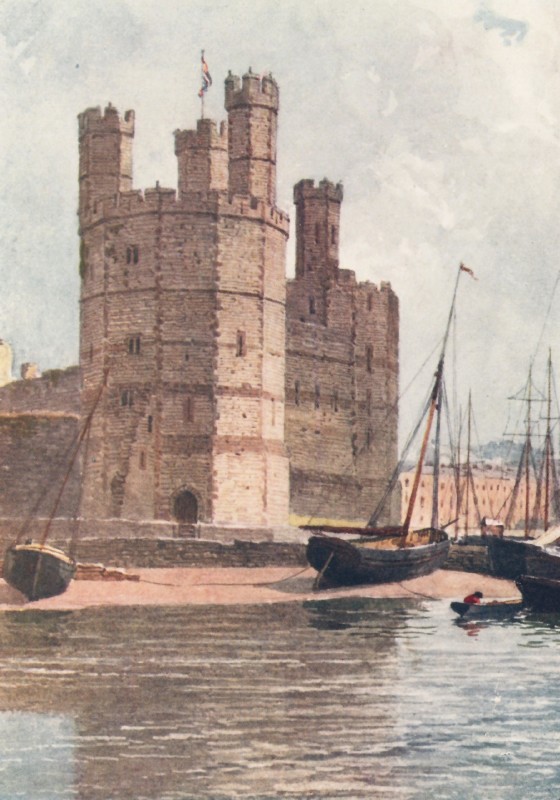CHAPTER
VI
AN
EISTEDDFOD
No one who knows and
loves Wales will have failed to be present at some time or another at
that most interesting and curious ceremony known as an Eisteddfod.
The name simply means a
"sitting," and probably refers, not to the spectators,
but to the "chairing" of the bard, which forms a chief
part in the proceedings.
These gatherings, for the
purpose of preserving the poetry and music of the country, are held
all over the land; but each year a great national Eisteddfod is held
at some convenient centre; and of this notice is published a year and
a day beforehand.
At the appointed time,
before crowds of spectators, the trumpets are sounded, and the
candidates are presented for the "degree" of bard. For this
they have to pass tests of various kinds, poetical and literary,
which are judged then and there. Then the "bards" present
their addresses to the audience—a poem, a prose composition, a
song, as the case may be. Musical competitions form a very marked
feature of the contest. From far and near the country choirs flock
in, and rival each other in choral and solo singing, until one is
adjudged the prize.
Other competitors play
the harp or violin, and when the contest is decided, the great
ceremony of "chairing the bard" begins. A "chair
subject" having been previously set for competition, the winner
is solemnly conducted to a chair of carved oak, a naked sword is held
over his head, and he is greeted with the blare of trumpets as the
bard. A concert, given by well-known singers, closes the proceedings,
which have often lasted for two or three days.

CARNARVON
CASTLE
This ceremony dates from
very far-off times. It may, indeed, be found in some form in the time
of that wonderful King Arthur of whom you have all heard.
He, as you know, was King
of Britain in the "days before history," and at his Court
it was the custom to set tests of valour to his knights. Once he set
seven of them to find fair Olwen, daughter of Thornogre Thistlehair,
chief of the Giants, and they were given a year and a day for their
quest. Of .the many wonderful adventures that befell them you may
read in a delightful collection of Welsh stories called the
"Mabinogion," or "Book for Girls and Boys."
At another Yule-tide his
nephew, Sir Gawayne, was put to a more severe test. A Green Knight of
immense stature rode into the dining-hall of the King, and dared any
knight present to give him, who was armed only with a holly-stick, a
blow with an axe, on the condition that he should receive a blow in
return a year and a day after the event.
Sir Gawayne proved
himself the only one who was not too dismayed at such a condition,
and with One good blow cut off the Green Knight's head, The latter,
however, merely picked it up, and held it aloft, upon which the head,
opening its eyes and addressing Sir Gawayne, said:
"Look you, be ready
as you have promised, and seek me till you find me. Get you to Green
Chapel a year and a day from now, there to receive a blow on New
Year's Eve."
The adventures of Sir
Gawayne must be read elsewhere. They form the subject of a fine
English poem of the fourteenth century, and were certainly of the
nature of a test of courage and endurance.
By the sixth century the
Eisteddfod seems to have become more of a test of poetical and
musical talent than of knightly skill and prowess. Those who proved
themselves worthy at the yearly gathering were classed as bards, and
were given the right of entry into the castles of all Welsh barons
and Princes. At one of the earliest of these meetings Gwynedd, Prince
of North Wales, in order to show how superior vocal music was to that
performed on instruments, offered a prize to the bards who should
swim over the Conway.
Eagerly the test was
accepted, but when they reached the farther bank the unfortunate
harpists found their strings were ruined by the water, while the
singers were merely braced up to even more successful efforts than
before.
In the twelfth century we
hear of a very notable Eisteddfod held at Caerwys, now a little
country-town, hidden away on a high tableland among the hills, but
notable in former days as the favourite residence of the last
Llewelyn. It was his ancestor, Griffith, who held there a gathering,
"to which there repaired all the men of Wales and also some from
England and Scotland," says the proud historian of the
event. And another is described as taking place at Cardigan
Castle, where assembled many bards, harpers, and minstrels, "the
best to be found in all Wales."
In the last century this
interesting old custom, which had become much neglected, was revived,
and now almost every Welsh town can boast of its own little
Eisteddfod, in which the various choirs of church and chapel, the
plough-boy poet and the clever school-child, all play their part in
keeping alive that spirit of poetry and music which is characteristic
of the national character of Wild Wales.
|

